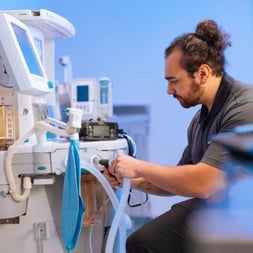When Medical Equipment Management Becomes a Patient Safety Issue: Rethinking HTM’s Role in Hospital Performance
 In the quest for clinical excellence, patient care remains the central focus. However, behind every diagnosis, treatment and successful outcome lies a critical, frequently underappreciated and often overlooked enabler: the medical equipment clinicians rely on every day.
In the quest for clinical excellence, patient care remains the central focus. However, behind every diagnosis, treatment and successful outcome lies a critical, frequently underappreciated and often overlooked enabler: the medical equipment clinicians rely on every day.
When that equipment isn’t clean, functional or readily available, the impact is immediate and the consequences are real: delays in care, potential safety risks, clinician stress and unnecessary costs.
Despite this, healthcare technology management (also known as clinical or biomedical engineering) is still viewed as a behind-the-scenes function — when it should be seen as a frontline patient safety imperative.
The Impact of Unavailable Equipment
Healthcare depends on more than just skilled clinicians and advanced treatments, it relies on the seamless availability, cleanliness and functionality of medical equipment. When that equipment is not managed efficiently, the consequences ripple across the entire care continuum.
- ED Backlogs: Lack of available equipment slows admissions and patient transfers
- Delayed Diagnosis & Treatment: Imaging and therapy are postponed when equipment isn’t ready
- HAIs from Improper Cleaning: Inconsistent cleaning processes increase infection transmission risk
- Extended Length of Stay & Readmissions: Equipment issues disrupt care and recovery timelines
- Clinician Burnout & Time Away from the Bedside: Staff waste time hunting around for devices or in some cases “sequester” them to ensure they have them when needed
- Capital Waste: Rental equipment levels in excess of what is truly needed and untracked or missing inventory erode margins
- Compliance & Reputation Risk: Missed maintenance and documentation gaps expose vulnerabilities that translate into care and financial risks
The Real Issue: Systemic Disconnect
At the root of these challenges is a lack of visibility, accountability and strategy around medical equipment:
- Assets aren’t tracked or monitored in real time
- Preventive maintenance may become reactive or not performed at all
- Cleaning workflows are often unclear or inconsistently followed
- Equipment planning is misaligned with clinical needs
These aren’t just operational pain points — they’re potential patient safety risks and barriers to performance.
HTM / Clinical Engineering Is Not Just Support. It’s Strategy
A high-performing HTM team is a clinical safety partner, not just a service group. The best programs:
- Prevent downtime with proactive maintenance
- Collaborate across departments (clinical, infection prevention, IT)
- Leverage data to improve utilization and reduce waste
- Understand how equipment impacts care at the bedside
- Ensure compliance with cleaning and regulatory standards
- Scale with your organization’s future
Medical equipment that is properly maintained and readily available is essential to safe, efficient patient care. It is time we start recognizing it as a foundational element of patient safety, not just a back-end support role.
Ready to reduce risk, improve workflow and patient flow, and protect your investments?
See what optimized equipment management can do for you.